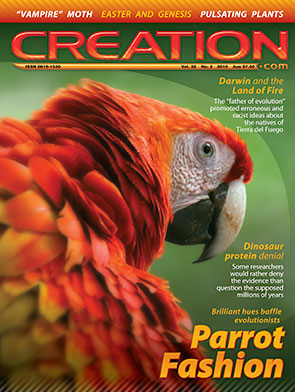Focus: creation news and views
Researcher speaks up on pressure to conform
According to Thomas Bouchard, a US psychologist famous for his research on twins raised apart, even scientists with good reason to believe that the majority are wrong can be silenced. The reason is the huge pressure to conform, the “powerful human urge to belong inside the group, to think like the majority … and to win the group’s approval by trashing dissenters.”

Bouchard, being interviewed in the journal Science on his retirement, said that, like teenagers, academics may not be aware of “the degree to which they are conformists”. A New York Times article about Bouchard’s views cited the case of economist Robert Shiller, an expert on house prices. While an advisor to the US Federal Reserve, he became deeply concerned about the bubbles developing in the US housing and stock markets. But rather than shout from the rooftops in warning the Fed, he expressed his views “very gently”. He said he “felt vulnerable”, because deviating too far from consensus “leaves one feeling potentially ostracized from the group, with the risk that one may be terminated.”
The article goes on to say that “conformity and group-think are attitudes of particular danger in science … because progress often depends on overturning established wisdom”. Bouchard was not suggesting that forming a consensus view was wrong, but the problem lay in the peer-pressure silencing of critics, saying that his field has “whole domains we can’t talk about”. The NY Times article says that if “the brightest minds on Wall Street got suckered by group-think into believing house prices would never fall”, who knows about such bandwagons as global warming, saying sarcastically, “You mean it might be harder to model climate change 20 years ahead than house prices 5 years ahead? Surely not—how could so many climatologists be wrong?”
People often ask us, “How could so many scientists be wrong” about evolution? Easy—see creation.com/herd-rule.
- The New York Times, tierneylab.blogs.nytimes.com, 23 July 2009.
Dinosaurs not so heavy

Researchers writing in the Journal of Zoology report that the original method used to estimate dinosaur weight is flawed, and therefore dinosaurs were only about half as heavy as has been mooted.
For example, Apatosaurus louisae, one of the largest dinosaurs, has been widely cited as weighing up to 38 tonnes, but this latest revision puts its weight at only 18 tonnes.
The researchers realized the original equation used to calculate total dinosaur mass was in error when they applied it to living animals such as the hippo and elephant, and found the method greatly overestimated their weights. So a new equation has been developed for calculating dinosaur mass based on bone dimensions. This suggests that many dinosaurs were actually much less massive than had been thought.
The new estimates have implications for numerous theories about the biology of dinosaurs, ranging from food requirements to modes of locomotion.
Apart from these findings underlining the need for skepticism regarding the claims of historical science, it slightly affects Christians’ answer to objections about Noah having taken dinosaurs on the Ark. Dinosaurs are still the same length, height, etc., but are now thought to be much less in mass. (Of course, the key to answering objectors is that Noah likely took juveniles, at least of the larger types, on board—see chapter 19 of The Creation Answers Book, available from addresses on p. 2.)
- Science Daily, www.sciencedaily.com, 22 June 2009.

Arm-swinging not an “evolutionary relic”
Scientists have been curious as to why we swing our arms as we walk, because, as they point out, “the arms play no obvious role in bipedal gait”. Some have even proposed that “arm swinging may be an evolutionary relic from quadrupedalism that serves little or no purpose”. Or, in the simpler language of another recent report on the topic, “arm-swinging, like our appendix, is an evolutionary relic from when we used to move about on all fours”—and so has no useful function today.
However, just as the evolutionary view of the appendix as a useless “vestigial organ” has had to be retracted given it has many known functions (see Creation 32(1):8, 2010 and creation.com/appendix4), so too with arm-swinging.
When researchers measured the energy costs of arm-swinging with the help of volunteers and a mechanical model, they found that it is “surprisingly small” in energy costs, requiring little torque, or rotational twist, from the shoulder muscles. In contrast, when volunteers forcibly held their arms still, or even forced their arms to move with an opposite-to-normal swing, the metabolic energy required increased by 12% and 26% respectively.
The researchers also found that normal arm-swinging helps to dampen the bobbing up-and-down motion of walking, which is itself an energy drain for the muscles of the lower legs. They conclude, “Rather than a facultative relic of the locomotion needs of our quadrupedal ancestors, arm swinging is an integral part of the energy economy of human gait.”
- Proceedings of the Royal Society B 276:3679–3688, 2009.
- ABC News in Science, www.abc.net.au, 29 July 2009.
These claws are made for climbin’ … ?
The vicious reputation of the dinosaur Velociraptor has a lot to do with its dagger-like sickle-shaped foot claw. Scientists believed this appendage, found in other members of the dromeosaur family, was for slicing and dicing other creatures; the movie Jurassic Park claimed its owner would use it for disembowelling live prey.
Now researchers at the UK’s University of Manchester claim that its real function was for climbing trees. It may have been used for clinging to prey as well, they state, and though it could have punctured the skin (perhaps after jumping on its prey out of a tree) it was “not sharp enough to rip the skin open”.
Other paleontologists accept that it was likely used for tree climbing in small dromeosaurids, but question whether this was so for large ones such as Utahraptor, at up to 6 metres (20 feet) in length and weighing hundreds of kilograms. They suggest that these co-opted the structure, which their ancestors used for climbing trees, to cling to prey.
All this is of considerable interest to creationists contemplating how various structures that seem designed to kill arose after the Fall (see The Creation Answers Book, chapter 6).
- New Scientist 203(2725):10, 2009.
Italy science council funds anti-evolution book
In 2009 Italy’s science agency, the National Research Council (CNR), hosted a panel to discuss flaws in evolutionary theory. And now CNR is helping to fund the publication of a follow-up book, Evolutionism: The decline of an hypothesis. In fact CNR’s Vice-President, historian and philosopher Roberto de Mattei, is the author.
However, CNR’s President, Luciano Maiani, was careful to publicly point out that while the organisation’s publishing arm independently approved funds for the book, CNR did not specifically back the book.
Nevertheless, critics were not happy with the CNR involvement in an anti-evolution book. University of Lecce zoologist Ferdinando Boero complained of “the paradox that while the Vatican [Pontifical] Academy of Sciences endorses evolutionism, the VP of the biggest scientific institution in Italy denies it.”
The book reportedly not only presents flaws in evolutionary theory but also addresses age issues, e.g. problems with radioactive dating, and it speaks of dinosaurs becoming extinct thousands of years ago, not millions.
- Scientific American, www.scientificamerican.com, 10 December 2009.
IBM wants to use DNA
Apparently recognizing good design when they see it, IBM is looking to the “building blocks” of life—DNA—to be the structure of next-generation microchips.
Microchips are used in electronic devices such as computers and mobile/cell phones. However, with the quest for tinier chips and the need to cut costs, the semiconductor industry is eager to incorporate the very best information storage and processing device known to man in their designs. (See Creation 25(2):26–31, 2003; creation.com/message.)
IBM research manager Spike Narayan said that the new technology is still at least a decade away. However, the quest will be worth it, as the ability to use biological structures like DNA means chip manufacturers will need far less complex equipment than at present, thus saving hundreds of millions of dollars.
- Reuters, www.reuters.com, 16 August 2009.

Spider silk: super muscle
While Kevlar is the strongest man-made fibre, humble spider silk is even stronger and more elastic. Dragline silk, the main support for a spider web, is a hundred times stronger than steel—a cable of silk a little thicker than a garden hose could support the weight of two full Boeing 737 aircraft (see Creation 23(2):21, 2001; creation.com/spidersilk.
Recently, Todd Blackledge of the University of Akron, Ohio, and his research team discovered a new property: it lengthens when dampened (not drenched), and shortens upon drying. This contraction exerts enormous force for its size. One fibre of the golden silk orb-weaver (Nephila clavipes) under contraction could lift a tenth of a gram, so a 2-cm-thick rope under contraction would be able to lift (not just support) a 2-tonne truck off the ground. Weight for weight, drying spider silk performs 50 times the work of a human muscle.
The researchers suggest that this could be a “biomimetic muscle” that could open tiny microspheres to deliver drugs to the body, or make a miniature electric generator powered by fluctuating humidity.
- New Scientist 202(2713):19, 2009.
- Journal of Experimental Biology 212(13):1981–1989, 1990–1994, 2009.
Darwin’s dark legacy
Many public defenders of evolution seemingly ignore creationist publications’ pointing out flaws in evolutionary theory—or at any rate, they remain silent. But they certainly become vocal (i.e. in protest) whenever creationists point out the link between evolutionary thinking and racism, Hitler’s actions, Stalin’s purges, etc. (See, e.g. creation.com/Darwin-historians-not-misrepresented and creation.com/Darwin-racism.)
So it was very refreshing to hear that British political journalist Dennis Sewell, despite wrongly believing that “evolution is scientifically undeniable”, readily admits that Darwin’s ideas have indeed fuelled racism. He acknowledges that racism was a widespread prejudice in British society before 1859, but Darwin’s presentation of races being different distances along the evolutionary path as a matter of science meant that “white Caucasians were at the top of the racial hierarchy, while black and brown people ranked below”.
Sewell also cited the Columbine killers (creation.com/bomb) and Finnish school shooter Pekka-Eric Auvinen (creation.com/killer) as examples “of how easily Darwin’s writings can lead to very disturbed ways of thinking”.
- Time, www.time.com, 24 November 2009.

Dinos on a beach?
Researchers have identified fossil footprints of sauropod dinosaurs near Nelson, New Zealand, which they claim are 70 million years old. They say the footprints were made in beach sands, then quickly covered and preserved by mud from subsequent tides.
But wait a minute—aren’t footprints that are left at the beach today washed away by subsequent tides, not preserved? Indeed, as the lead researcher, Dr Greg Browne, tacitly recognized: “What makes this discovery special is the unique preservation of the footprints in an environment where they could easily have been destroyed by waves, tides, or wind.”
Surely the “unique preservation” of these dino footprints required a unique event involving rapid inundation by sediment-laden water, complete with cementing agent. In Genesis 6–9 the Bible details just such an event, a global Flood about 4,500 years ago, which means the dino footprints are not millions of years old at all. (See Creation 25(2):10–12, 2003, creation.com/dinotracks; also creation.com/terrible.)
- New Zealand Journal of Geology and Geophysics 52(4):367–377, 2009.
- ABC News in Science, www.abc.net.au, 9 November 2009.
DNA repair uses electrical signals
The DNA in our cells gets damaged and needs to be repaired. Failure to fix the damage causes cancer. Our cells have nano-machines that travel along the strands of DNA to find the errors and repair them. But this is a big job—with 3,000 million “letters” on the human DNA to check and not many of the nano-machine checkers, it would take a long time.
Scientists proposed some years ago that DNA might act as an electrical conductor and this could be involved in error checking and other functions. (See Creation 29(2):40–41, 2007; creation.com/electric-dna.) Researchers at Caltech have now provided evidence that the DNA repair machines use the electrical conductivity of the DNA to locate the errors. A pair of repair enzymes, known as EndoIII and MutY, cooperate to detect faults in the transfer of an electronic charge from one to the other along a few hundred base pairs (letters) of the DNA, which then indicates a fault in the DNA in that section. Then the faulty section is searched to locate the faulty base pair and repair it. Sections that allow charge transfer don’t have any errors and are skipped from detailed checking. In this way the checking process is very rapid and efficient.
Even believing in a Creator, we are continually amazed at the incredibly efficient, intricate design of living things. This sort of discovery multiplies the problems for those who try to explain everything without a Creator—how could any repair mechanism come into existence without intelligent design, let alone one so sophisticated? And life could not exist without it!
(Natural selection could not work unless the selected information could be transmitted almost error-free. Thus it can’t explain its origin.)
- PNAS 106(36):15237–15242, 8 September 2009.
Pterosaur landing tracks
Pterosaur tracks found preserved in rock in France, dated by paleontologists to around 150 million years ago, appear to have been made as the creature landed.
The first of these “exceptional” footprints are of the hind limbs only. It seems that the pterosaur landed gently on its hind feet before hopping forward and using its “hands” to stabilise itself, then walking away on all fours.
One of the palaeon tologists said that the tracks record “a small moment, perhaps no more than 3 seconds, in the life of a pterosaur”. Just 3 seconds to make—but how long to preserve? Today’s bird landing prints generally don’t last for very long at all, so why did these?
The exceptionally-preserved track marks are indicative of rapid (not slow-and-gradual) burial, and when taken together with other similarly well-preserved fossils worldwide, fit the pattern expected from the biblical Flood of Noah’s day—only some thousands of years ago, not millions. See creation.com/seeing-the-pattern.
- New Scientist 203(2722):9, 22 August 2009.
Man can do better than the Creator?

Researchers at Imperial College, London, say that photosynthesis in leaves is one of evolution’s crowning achievements. This is the process where plants use sunlight to convert water and carbon dioxide into energy-rich usable sugars. The complex chemistry enables “the most effective solar energy conversion process on Earth.” (See creation.com/greenpower.)
So the researchers are embarking on an “artificial leaf” project to produce power by mimicking photosynthesis. In fact, leader of the artificial leaf project, biologist James Barber, is even hoping to improve on nature’s solar cell.
“If the leaf can do it, we can do it but even better,” he said.
Such a view is common among scientists who believe that life just evolved. If life’s complexity has been produced by time and chance, they reason, surely much-improved engineering feats can be achieved with intelligent scientists’ input?
However, on the basis of achievement to date, such optimism is not well-founded. For a start, despite worldwide research effort over many decades (as we’ve previously reported, e.g. Creation 31(3):8, 2009; 30(4):8, 2008), scientists have a long way to go yet before their artificial “photosynthesis” systems might rival the effectiveness of plant leaves. In fact, the chemistry of nature’s highly complex and efficient photosynthetic apparatus has not even been fully worked out yet, let alone copied!
If, one day, man does succeed in emulating or re-engineering what plants can do, it won’t have been the result of time-and-chance processes, but intelligent design. And it will surely point to a supremely Intelligent Designer who designed the plants in the first place (Romans 1:20).
- The Guardian, www.guardian.co.uk, 11 August 2009.
Our galaxy: The centre of the universe

The universe has characteristics which challenge evolutionary models. For example, astronomers have observed data they interpret to mean that the galaxies are accelerating as they move away from each other. Cosmologists have sought to explain this unexpected acceleration by introducing the concept of “dark energy”.
However, a recent paper in the Proceedings of the National Academy of Sciences (USA) by mathematicians Blake Temple (University of California) and Joel Smoller (University of Michigan) presents a whole new set of calculations that “allow for all the sums to add up without the need for this controversial substance”, i.e. without so-called dark energy.
The key point to note is that Temple and Smoller’s calculations put our galaxy as being at the centre of the universe—and it all fits. Actually, one might almost think they’ve been reading creationist literature, especially work by US physicist Dr Russ Humphreys—see, e.g., Journal of Creation 21(2):61–70, 2007 (note especially endnote 19), and by Australian physicist/CMI speaker Dr John Hartnett—see Journal of Creation 18(1):9, 2004.
Traditionally, there has been extreme reluctance by evolutionary cosmologists to consider our galaxy as being at the centre of the universe. Understandably so, given the implication—namely that God has put us in a special place in His vast universe.
- PNAS 106(34):14213–14218, 25 August 2009; pnas.org/content/106/34/14213.
- The Telegraph (UK), www.telegraph.co.uk, 18 August 2009.
Non-marine fossil surprise
Most of us have been told all our lives that animal life evolved in the sea, but now a new study claims that it might have begun in freshwater lakes. This is how the researchers interpreted some microscopic fossil embryos found in China. Martin Kennedy, a geologist at the University of California at Riverside, said, “It is most unexpected that these first fossils do not come from marine sediments.”
God, the only eye-witness of Creation, tells us in Genesis 1:20 that He created the first animal life in “the waters” on day 5 of creation week, but He created the first living things as plants on the land (verse 11), on day 3 of creation week.
- University of California—Riverside newsroom, newsroom.ucr.edu, 27 July 2009.
- Proceedings of the National Academy of Sciences USA 106(32):13190–13195, 11 August 2009.

Birds “see” magnetic field lines
Many birds migrate over vast distances, arriving with pin-point accuracy at their destination year-by-year. Scientists have shown that birds can sense the earth’s magnetic field in some way. This enables them to navigate in cloudy weather and over featureless ocean stretches. But how do they do it?
Some have suggested that the birds sense tiny forces on iron particles in their beaks. However, when researchers cut the nerves connecting European robins’ beaks to their brains, the robins could still navigate using the magnetic field. But when the birds had lesions in the part of their brains that processes signals from the light-sensing cells in their eyes, they could not navigate. So the researchers concluded that the birds ‘see’ Earth’s magnetic field with their eyes. But just how this is possible is not at all clear yet.
This discovery underlines again the poverty of the argument that vertebrate eyes (such as birds’) are badly designed!
- Inside Science News Service, www.insidescience.org, 16 November 2009.









Readers’ comments
Comments are automatically closed 14 days after publication.